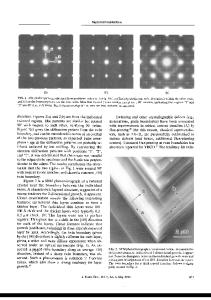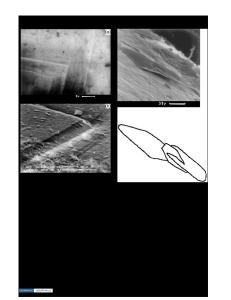Magnetic Relaxation in Bi 2 Sr 2 Ca 1 Cu 2 O 8+x Single Crystal
- PDF / 199,737 Bytes
- 4 Pages / 420.48 x 639 pts Page_size
- 31 Downloads / 358 Views
MAGNETIC RELAXATION IN Bi 2 Sr2CalCU2O8+x SINGLE CRYSTAL E. AGOSTINELLI
,
G. BALESTRINO
,
D. FIORANI
,
P.
PAROLI
,
J.
TEJADA , A.M. TESTA * I.T.S.E. , C.N.R., Area della Ricerca, Roma, Italy ** Dept. of Physics, University of Salerno, Salerno, Italy *** Dept. of Mechanical Engineering, University of Tor Vergata, Roma, Italy **** Dep. de Fisica Fonamental, Universidad de Barcelona, Spain ABSTRACT The results of measurements of critical currents and magnetic relaxation on a Bi 2 Sr 2 CaiCu 2 08 +x single crystal are reported. Activation energies for the flux motion have been determined from the temperature dependence of the critical current density and the time decay of the zero-field-cooled and the remanent magnetization. The effective activation energy increases with temperature, in agreement with the existence of a distribution of activation energies. INTRODUCTION The critical current density in high TC superconductors is strongly limited by the weakness of the coupling between the grains and by the rapid thermally activated flux motion. While the first source of limitation of Jv depends on the type of physical aggregation, the second one is an intrinsic feature of the material, as shown by the strong relaxation of the magnetization occurring in sintered as well as in single crystals and thin films materials.
With respect to conventional superconductors, in the high TC ones the weakness of the pinning [1,2], combined with the much higher thermal energy available, make the fluxons more mobile and the dissipation effects more pronounced. RESULTS AND DISCUSSION The measurements were performed on a Bi 2 Sr 2 CaiCu 2Oa+x single crystal (nominal composition), grown by the flux technique [3]. The magnetic properties were investigated by AC susceptibility measurements, using a mutual inductance bridge (Hat= 1 Oe at'? = 200 Hz) and by DC magnetization measurements, using a commercial SQUID magnetometer. X-ray diffraction showed reflections due to the 2212 phase only. The AC susceptibility curve (Fig.l), measured applying the magnetic field both parallel and perpendicular to the c-axis, showed only one transition at 85 K ascribed to the 2212 phase, without any detectable drop at 110 K. This indicates the absence of any contribution from the higher Tc phase. Magnetization cycles have been performed at different temperatures. The cycle amplitude, which in the Bean critical state model is connected to the critical current density Jc , decreases rapidly with increasing temperature. This indicates a strong field dependence of Jc even at temperatures well below Tc . Mat. Res. Soc. Symp. Proc. Vol. 169. ©1990 Materials Research Society
928
determined JC in zero field at different We have temperatures from the measurements of the remanent magnetization after the application of 5 T. Using Bean's formula, our sample 0-5
.1
DI3-00.i1 1Of-
,
,
,
,
90
105
120
135
++ +
-10 +1--4 +++++
?
-15 0
d
-20
-25 13 -30 -35 1equ-d0 dPI 0 15 30 45
60
75 T(K)
Fig.1 AC susceptibility curve for H//c(0)
and Hlc(+)
has
Data Loading...











